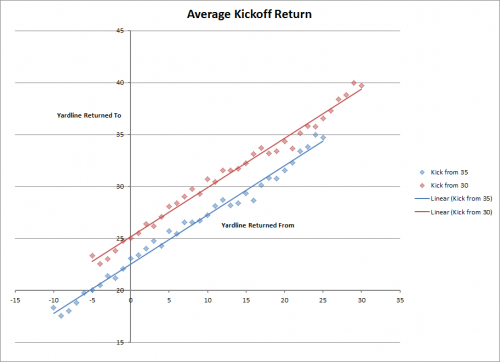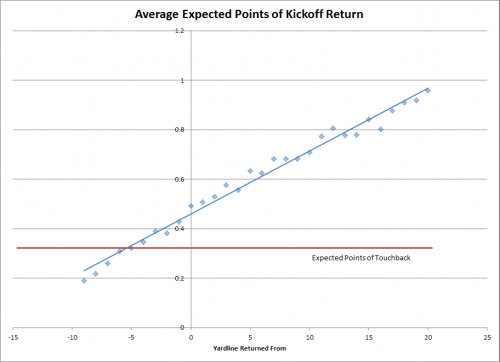 Unless you’ve been living under a rock, you’ve heard that the NFL moved the kickoff line forward 5 yards to the 35 yard line. The hope is that this will result in more touchbacks and, therefore, fewer injuries due to fewer returns.
Unless you’ve been living under a rock, you’ve heard that the NFL moved the kickoff line forward 5 yards to the 35 yard line. The hope is that this will result in more touchbacks and, therefore, fewer injuries due to fewer returns.
With more kickoffs going into the end zone, returners are faced with many more decisions. With apologies for the poor title of this post, the question still remains for returners: Should I take it out, or take a knee? I’m going to try to shed some light on the returners’ decision.
Average Returns
In the past, with the kickoff line at the 30, kickoffs that went to the goalline were returned on average to the 25 yard line. To estimate where we’d expect returns to go this year, we want to do it based on how far the kickoff goes, NOT simply where the kick ended up. Mainly, this is because the kickoff coverage is 5 yards closer. Another factor is that the average hangtime on kicks is based on kick yardage as well. Take an example: I just stated that returns from the goalline in the past were returned 25 yards. Should we expect returns from the goalline now to go 25 yards? No. We’d expect them to be shorter since the coverage team will get their faster and the hangtime will be longer as the kick is only traveling 65 yards, not 70.
Let’s take a look at the average return based on where the returner catches the kickoff.
The two sets of points are identical, just shifted by 5 yards. For example, a kick that travels 70 yards would be caught at the goalline and returned 25 yards to the 25 yard line in the past (kickoffs from the 30). Now, the kick would be caught 5 yards deep in the end zone, still returned 25 yards, and would end up around the 20.
What we see in the chart is that each extra yard that the kick travels adds 1/2 a yard to the return. A 70 yard kick is returned 25 yards, so a 71 yard kick will be returned 25.5 yards on average, a 72 yard kick will be returned 26 yards, and so on. Again this makes sense, as these kicks are traveling further, making it longer for the coverage players to go and decreasing the height of the kick.
When to take it out…and when to take a knee
Based on the chart above, you can see that the kick returner can expect to get to the 20 yard line or further all the way back to 5 yards deep in his own end zone. Based on this evidence, kicks caught 6 yards deep or further should be kneed, and all others should be taken out.
Before we accept that s our answer, let’s look at from the perspective of Expected Points. Average return yard line is a good first step, but EP will be able to capture more by looking at the actual distribution of returns.
The story remains the same. Right around 5 yards deep in the end zone is cutoff point for taking the kick out. 1st and 10 from the 20, which is what the offense would get on a touchback, is worth about 0.32 points. A return from 5 yards deep is almost exactly the same.
Conclusion
There’s a couple more factors I haven’t discussed yet. First, the risk of a fumble or penalty hurts the returning team, depressing the value of taking it out of the end zone. However, there is also increased variance in taking it out, which benefits underdogs and/or teams that find themselves behind on the scoreboard. Those teams should be more inclined to risk taking it out, while favorites and teams in the lead should be more inclined to take a knee.
The final factor I want to discuss is that the “average” kickoff return obviously includes all returners, good, bad, and everywhere in between. In the past, there were few decisions to be made. Any kick caught outside the end zone should obviously be returned and the few that traveled into the end zone were likely not deep enough to matter. Almost all kickoffs should have been returned in the old format. If the average return from the goalline was 25 yards, this likely included the Devin Hesters of the world averaging more than 25 yards, while poorer return units like that of my Indianapolis Colts were likely below 25.
In this new system, the weaker units can choose to take a knee more often, while the better returnmen–who likely have much higher value than the average returner–can take it out much more often, perhaps even 8 or 9 yards deep in the end zone. In the end, we should still see plenty of kickoff returns this season, especially from the most exciting and explosive return guys.



I would be interested in seeing the 95% CI’s for each of those points. With that, you could at least get a sense when you absolutely, no doubt in your mind, should return the ball. Also, this will give us a sense of how much these returns vary by and how (e.g. are they symmetric?).
James, maybe I’ll do a follow up and look deeper. As for now, I’m content saying that somewhere around 5 yards deep is a decent break even point. Clearly anything at the goalline or in front is an automatic return. From there, it depends on the quality of your kick return unit and the game situation. Your addition would let us be a little more precise in those recommendations. Thanks.
The coverage guys get a shorter head start. Simply shifting your line 5 yards isn’t correct analysis.
Dave, you are right. I personally don’t think that is much of a factor, but after a few more weeks of data from this year, that is definitely something I should check. Thanks for pointing that out.
My gut has always told me it is better to take it out nearly always, even in the new regime as the chance of a big return is worth more than the risk of starting at the 17 instead of the 20. That said, I don’t know how many fumbles happen on returns or how damaging it is really to start at the 17 vs the 20 so I don’t really have the data to make this argument. Just my hypothesis based on watching.
5/Daryl, the analysis uses Expected Points so should take into account big plays. Fumbles (and penalties) were not included and would only hurt the returning team. I think in the past, you were probably right that teams should almost always take it out, but with the kicking team 5 yards closer it looks like those kickoffs in the back half of the endzone may not be worth it to bring out.
As far as the risk-reward goes, this reminds me of my punt return days in high school. My dad and I felt that on punt returns, it was worth going side-to-side or backwards in the hope of breaking a long one since no matter where you got tackled it was 1st and 10, as opposed to just running straight up the field and getting 5-10 yards with little chance of breaking one. Similar dynamics at work here on kickoffs, though you are in a more dangerous part of the field and punts are more of a broken field whereas kickoffs seem to be more closed.
Actually clarification, I used expected points of the average return (not expected points of the distribution of returns), so I’d need to look at that to be sure. However, since it will be 1st and 10 no matter what, and EP on 1st and 10 is rather linear, I’m guessing it won’t change much if at all.
What’s up,I read your new stuff named “To Knee or Not To Knee — Outside the Hashes” regularly.Your humoristic style is witty, keep doing what you’re doing! And you can look our website about proxy list.